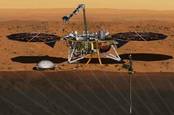This article is more than 1 year old
Astronomers get more than they bargained for, as Mars probe InSight's instruments detects solar eclipses
Tiny tilt from the probe's seisometer could map Phobos' orbit and help boffins predict when it'll crash into Mars
The seismometer and magnetometer on NASA’s Martian InSight probe specifically designed to detect marsquakes have proved unexpectedly sensitive enough to respond to Martian eclipses too, scientists report.
Astronomers usually rely on cameras to study Martian solar eclipses as parts of the Sun are temporarily swallowed as the moon Phobos flits across. But now, there are two other instruments onboard the InSight lander that can enrich solar observations: the magnetometer and seismometer.
The magnetometer is designed to measure the strength of the magnetic field below the surface, but during a solar eclipse boffins have noticed readings dropping. Simon Stähler, first author of the study published in Geophysical Research Letters and a researcher at ETH Zurich’s Institute of Geophysics, said the decrease made sense since the solar cells powering the lander’s instruments received less light. “When Phobos is in front of the sun, less sunlight reaches the solar cells, and these in turn produce less electricity.”
The seismometer detects records of grumbles from marsquakes underground, and whenever Mars receives less sunlight from the Sun during an eclipse it wobbles to one side.

Thanks to the NASA InSight probe (and British tools), you can now listen to the sound of a Martian earthquake
READ MORE“This tilt is incredibly small,” Stähler said. “Imagine a 5-franc coin; now, push two silver atoms under one edge. That’s the incline we’re talking about: 10-8.” At first, Stähler and his colleagues reckoned it had something to do with Phobos’ gravity, maybe it was tugging on Mars in a similar fashion to how how the Moon pulls on the Earth to create tides.
“We didn’t expect this seismometer reading; it’s an unusual signal,” Stähler added.
Upon closer inspection, however, they realized that it couldn’t be related to Phobos’ gravity after all. There are other scenarios when Phobos passes Mars that should in theory produce similar tilts, but they were only observed during solar eclipses. Instead, they discovered that it was down to a much simpler effect: A drop in temperature.
“During an eclipse, the ground cools. It deforms unevenly, which tilts the instrument,” said Martin van Driel, co-author of the paper, who also works at the ETH Zurich’s Institute of Geophysics. An infrared sensor revealed that the ground cooled by two degrees celsius during just 30 seconds of the eclipse, and shifted just enough to affect the seismometer.
The minuscule tilt might not sound all that useful at first, but the team believes that it could help scientists plot Phobos’ orbit more precisely. That would help future missions like Japan’s Aerospace Exploration Agency goal to return samples from Phobos.
It’d also help astronomers predict how the irregular-shaped satellite will evolve; it’s slowing down and inching increasingly towards Mars and is expected to come crashing down on the planet’s surface in 30 to 50 million years time.
“We can use this slight slowdown to estimate how elastic and thus how hot the Martian interior is; cold material is always more elastic than hot,” Amir Khan, co-author of the paper, and a member of ETH Zurich’s Institute of Geophysics, concluded. ®
